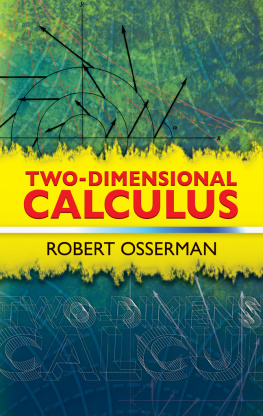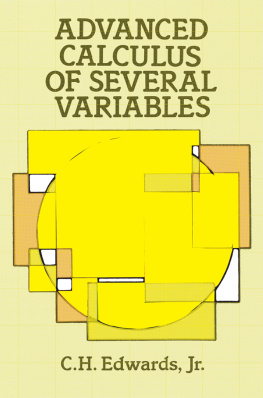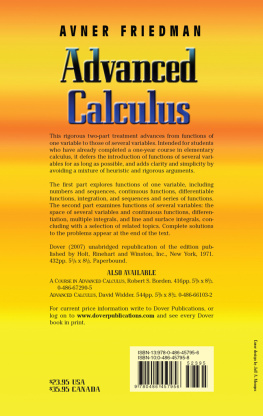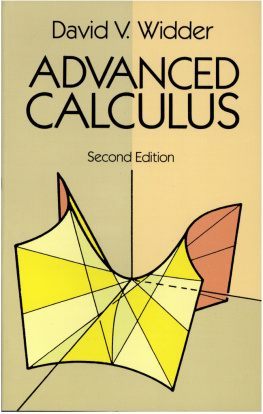Robert C. Wrede - Advanced Calculus
Here you can read online Robert C. Wrede - Advanced Calculus full text of the book (entire story) in english for free. Download pdf and epub, get meaning, cover and reviews about this ebook. year: 2010, publisher: McGraw-Hill Education, genre: Children. Description of the work, (preface) as well as reviews are available. Best literature library LitArk.com created for fans of good reading and offers a wide selection of genres:
Romance novel
Science fiction
Adventure
Detective
Science
History
Home and family
Prose
Art
Politics
Computer
Non-fiction
Religion
Business
Children
Humor
Choose a favorite category and find really read worthwhile books. Enjoy immersion in the world of imagination, feel the emotions of the characters or learn something new for yourself, make an fascinating discovery.

- Book:Advanced Calculus
- Author:
- Publisher:McGraw-Hill Education
- Genre:
- Year:2010
- Rating:4 / 5
- Favourites:Add to favourites
- Your mark:
- 80
- 1
- 2
- 3
- 4
- 5
Advanced Calculus: summary, description and annotation
We offer to read an annotation, description, summary or preface (depends on what the author of the book "Advanced Calculus" wrote himself). If you haven't found the necessary information about the book — write in the comments, we will try to find it.
Advanced Calculus — read online for free the complete book (whole text) full work
Below is the text of the book, divided by pages. System saving the place of the last page read, allows you to conveniently read the book "Advanced Calculus" online for free, without having to search again every time where you left off. Put a bookmark, and you can go to the page where you finished reading at any time.
Font size:
Interval:
Bookmark:
Advanced Calculus
San Jose State UniversityMurray R. Spiegel, Ph.D.Former Professor and Chairman of Mathematics
Rensselaer Polytechnic Institute
Hartford Graduate CenterSchaums Outline Series

 Copyright 2010, 2002, 1963 by the McGraw-Hill Companies, Inc. All rights reserved. Except as permitted under the United States Copyright Act of 1976, no part of this publication may be reproduced or distributed in any form or by any means, or stored in a database or retrieval system, without the prior written permission of the publisher. ISBN: 978-0-07-162367-4 MHID: 0-07-162367-1 The material in this eBook also appears in the print version of this title: ISBN: 978-0-07-162366-7, MHID: 0-07-162366-3. All trademarks are trademarks of their respective owners.
Copyright 2010, 2002, 1963 by the McGraw-Hill Companies, Inc. All rights reserved. Except as permitted under the United States Copyright Act of 1976, no part of this publication may be reproduced or distributed in any form or by any means, or stored in a database or retrieval system, without the prior written permission of the publisher. ISBN: 978-0-07-162367-4 MHID: 0-07-162367-1 The material in this eBook also appears in the print version of this title: ISBN: 978-0-07-162366-7, MHID: 0-07-162366-3. All trademarks are trademarks of their respective owners. Rather than put a trademark symbol after every occurrence of a trademarked name, we use names in an editorial fashion only, and to the benefit of the trademark owner, with no intention of infringement of the trademark. Where such designations appear in this book, they have been printed with initial caps. McGraw-Hill eBooks are available at special quantity discounts to use as premiums and sales promotions, or for use in corporate training programs. To contact a representative please e-mail us at bulksales@mcgraw-hill.com. TERMS OF USE This is a copyrighted work and The McGraw-Hill Companies, Inc. (McGraw-Hill) and its licensors reserve all rights in and to the work.
Use of this work is subject to these terms. Except as permitted under the Copyright Act of 1976 and the right to store and retrieve one copy of the work, you may not decompile, disassemble, reverse engineer, reproduce, modify, create derivative works based upon, transmit, distribute, disseminate, sell, publish or sublicense the work or any part of it without McGraw-Hills prior consent. You may use the work for your own noncommercial and personal use; any other use of the work is strictly prohibited. Your right to use the work may be terminated if you fail to comply with these terms. THE WORK IS PROVIDED AS IS. McGRAW-HILL AND ITS LICENSORS MAKE NO GUARANTEES OR WARRANTIES AS TO THE ACCURACY, ADEQUACY OR COMPLETENESS OF OR RESULTS TO BE OBTAINED FROM USING THE WORK, INCLUDING ANY INFORMATION THAT CAN BE ACCESSED THROUGH THE WORK VIA HYPERLINK OR OTHERWISE, AND EXPRESSLY DISCLAIM ANY WARRANTY, EXPRESS OR IMPLIED, INCLUDING BUT NOT LIMITED TO IMPLIED WARRANTIES OF MERCHANTABILITY OR FITNESS FOR A PARTICULAR PURPOSE.
McGraw-Hill and its licensors do not warrant or guarantee that the functions contained in the work will meet your requirements or that its operation will be uninterrupted or error free. Neither McGraw-Hill nor its licensors shall be liable to you or anyone else for any inaccuracy, error or omission, regardless of cause, in the work or for any damages resulting there from. McGraw-Hill has no responsibility for the content of any information accessed through the work. Under no circumstances shall McGraw-Hill and/or its licensors be liable for any indirect, incidental, special, punitive, consequential or similar damages that result from the use of or inability to use the work, even if any of them has been advised of the possibility of such damages. This limitation of liability shall apply to any claim or cause whatsoever whether such claim or cause arises in contract, tort or otherwise.
Third Edition
These remain an integral part of this manuscript. In this third edition, clarifications have been provided. In addition, the continuation of the interrelationships and the significance of concepts, begun in the second edition, have been extended.
Second Edition
Advanced calculus is not a single theory. However, the various sub-theories, including vector analysis, infinite series, and special functions, have in common a dependency on the fundamental notions of the calculus. An important objective of this second edition has been to modernize terminology and concepts, so that the interrelationships become clearer. For example, in keeping with present usage functions of a real variable are automatically single valued; differentials are defined as linear functions, and the universal character of vector notation and theory are given greater emphasis. Further explanations have been included and, on occasion, the appropriate terminology to support them. The order of chapters is modestly rearranged to provide what may be a more logical structure.
A brief introduction is provided for most chapters. Occasionally, a historical note is included; however, for the most part the purpose of the introductions is to orient the reader to the content of the chapters. I thank the staff of McGraw-Hill. Former editor, Glenn Mott, suggested that I take on the project. Peter McCurdy guided me in the process. Barbara Gilson, Jennifer Chong, and Elizabeth Shannon made valuable contributions to the finished product.
Joanne Slike and Maureen Walker accomplished the very difficult task of combining the old with the new and, in the process, corrected my errors. The reviewer, Glenn Ledder, was especially helpful in the choice of material and with comments on various topics. ROBERT C. WREDE
Numbers
Numbers
The language is given structure with the aid of connective symbols, rules of operation, and a rigorous mode of thought (logic). These concepts, which previously were explored in elementary mathematics courses such as geometry, algebra, and calculus, are reviewed in the following paragraphs.
The set consisting of no elements is called the empty set
Font size:
Interval:
Bookmark:
Similar books «Advanced Calculus»
Look at similar books to Advanced Calculus. We have selected literature similar in name and meaning in the hope of providing readers with more options to find new, interesting, not yet read works.
Discussion, reviews of the book Advanced Calculus and just readers' own opinions. Leave your comments, write what you think about the work, its meaning or the main characters. Specify what exactly you liked and what you didn't like, and why you think so.










